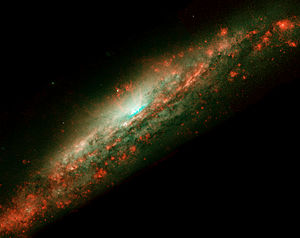NGC 3079
| Galaxy NGC 3079 |
|
|---|---|

|
|
| Photo from the Hubble Space Telescope | |
| AladinLite | |
| Constellation | Big Bear |
|
Position equinox : J2000.0 , epoch : J2000.0 |
|
| Right ascension | 10 h 01 m 57.8 s |
| declination | + 55 ° 40 ′ 47 ″ |
| Appearance | |
| Morphological type | SB (s) c / LINER / Sy2 |
| Brightness (visual) | 10.8 mag |
| Brightness (B-band) | 11.5 likes |
| Angular expansion | 8.1 ′ × 1.3 ′ |
| Position angle | 165 ° |
| Surface brightness | 13.2 mag / arcmin² |
| Physical data | |
| Affiliation |
NGC 3079 group LGG 188 |
| Redshift | 0.003723 ± 0.000003 |
| Radial velocity | 1116 ± 1 km / s |
|
Stroke distance v rad / H 0 |
(53 ± 4) · 10 6 ly (16.1 ± 1.1) Mpc |
| Absolute brightness | −20.1 mag |
| history | |
| discovery | Wilhelm Herschel |
| Discovery date | April 1, 1790 |
| Catalog names | |
| NGC 3079 • UGC 5387 • PGC 29050 • CGCG 266-008 • MCG + 09-17-010 • IRAS 09585 + 5555 • 2MASX J10015792 + 5540480 • GC 1983 • H V 47 • spar 156A • LDCE 700 NED002 | |
NGC 3079 is a bar-spiral galaxy with an active nucleus of the Hubble type E3 in the constellation Great Bear in the northern sky . It is an estimated 53 million light-years away from the Milky Way and about 120,000 light-years across.
In the same area of the sky is u. a. the galaxy NGC 3073 .
From the center of this galaxy , hot gases about 3,000 to 3,500 light years in size shoot out. They come from violent star formations, so-called starbursts .
The Type Ic supernova SN 2001ci was observed here.
The object was discovered on April 1, 1790 by the German-British astronomer Wilhelm Herschel .
Web links
Commons : NGC 3079 - collection of images, videos, and audio files

